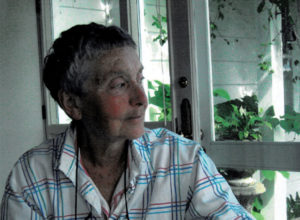Donor Profile: Eva Moseley
Written by Lee S. Polansky, Senior Director of Executive Initiatives and Special Projects | Interview by Sarah Ikemoto, Development Manager | Published: December 12, 2022

Eva Moseley has led a noteworthy life since her childhood in Vienna. She emigrated from Austria to the U.S. with her family shortly before the Nazis perpetrated the Final Solution. She attended Mount Holyoke, a Seven Sisters College, earned an MA in Sanskrit and Indian Studies at Harvard, married and had two children. She spent her career as the manuscripts curator of the Schlesinger Library at Radcliffe College, the leading center for research on the history of women in the U.S. Being curator was her ideal job, she said: “It made me a feminist, a willing public speaker, and I hope a collegial boss.” Here is our interview with Eva.
Your family emigrated from Austria to the U.S. around the time of Kristallnacht in 1938. Can you tell our readers what it was like, leaving Austria at such a scary time?
For me, at age seven, emigrating was “a safe adventure.” I was with my family and we had a fairly easy trip by train and ship, like tourists, without the uncertainty, harassment, or dangers most refugees suffered.
On Kristallnacht, my father was sent to Dachau concentration camp for the “crime” of being Jewish. Luckily, he was there for only three months. Before the Nazis launched the Final Solution in 1942, it was possible for Jews to emigrate from Austria, which was by then part of Germany. But another country would have to accept you. The U.S. didn’t accept many refugees, but my mother had rich cousins in New York who helped us have that safe trip immigrating to the U.S..
Tell us a bit about your family, your American childhood, college, and beyond.
My mother resumed dressmaking, making beautiful clothes for wealthy women, some of them also refugees. My mother’s cousins owned apartment buildings, and hired my father as a painter and handyman. Later, he had other jobs–but his real calling was the outdoors. He introduced us to congenial people and activities at Camp Midvale, which was in the hills of northern New Jersey. Midvale was a racially-integrated, socialist-leaning camp that attracted mainly German-speaking working-class immigrants and their offspring
Getting used to another language and culture was easier for me than the others, including my brother, Paul, who was ten. Paul and I went to New York City public schools. While he earned a degree in engineering at City College, I left NYC for Mount Holyoke College, where I earned a BA in Philosophy. Continuing my then-interest in mystical traditions, I earned an MA in Sanskrit and Indian Studies at Harvard.
Instead of living the scholarly life, I turned to jobs related to Asia, which is how I met my husband, George Moseley. We lived in a number of different countries: Macau (where George represented CARE); New Haven (he got an MA at Yale, and our daughter, Jessica, was born); NYC (where Tom was born); a year each at Harvard, and the University of London; and a year at Oxford University before and after a year in Hong Kong.
George then taught at Goddard College (Vermont); Tufts University (Massachusetts); and George Mason University (Virginia). He wrote four books on China, and I typed, edited, and indexed three of them—which was then typical of scholars’ wives. While he was at Tufts University, he (also typically) left us.
Switching gears, when did you become interested in population issues? And when did you discover Population Connection (known then as ZPG)? What inspired you to join ZPG/Population Connection?
As for ZPG, I was briefly and modestly active, I think in the 1990s, but I was more inclined to help financially, even if modestly, as my job left me with little energy for activism. After I retired, I was active mainly in the peace movement. Not all would agree, but I see reasonable population size (2-4 billion?) as a prerequisite for peace.
What do you think people can and should do to address rapid population growth?
Have few (or no) children. Learn about the realities of the climate and the environment more generally, and learn enough human history to have a realistic view of our limited capacity, as a species, to behave rationally and altruistically, for the common good. It would help if more people thought in terms of a long future (beyond their own), and a wider present and near-future, also beyond their own.
What do you hope that Population Connection achieves in the near future?
One concrete achievement would be a binding U.S. law establishing true reproductive freedom; and another, the permanent abolition of the Global Gag Rule. If feasible, end family subsidies for, say, more than three children per couple. (Two would be even better.) Unfortunately, current trends are just about the opposite of all this.
Why did you decide to establish a Charitable Gift Annuity with Population Connection, and what does it mean for you to be a member of our legacy group, the ZPG Society?
At 91, I’m not much of an activist any more, but it’s good to think that some money I give will be helping Population Connection with its essential work, long after I’m gone.
We hope you found Eva as interesting as we did! If you’d like to learn more about her life (e.g., why Mount Holyoke, and a pre-Roe abortion), please buy her memoir, published in May 2022. You can order Skirting History: Holocaust Refugee to Dissenting Citizen (Olive Branch Press, 2022), preferably from your local independent bookstore.
